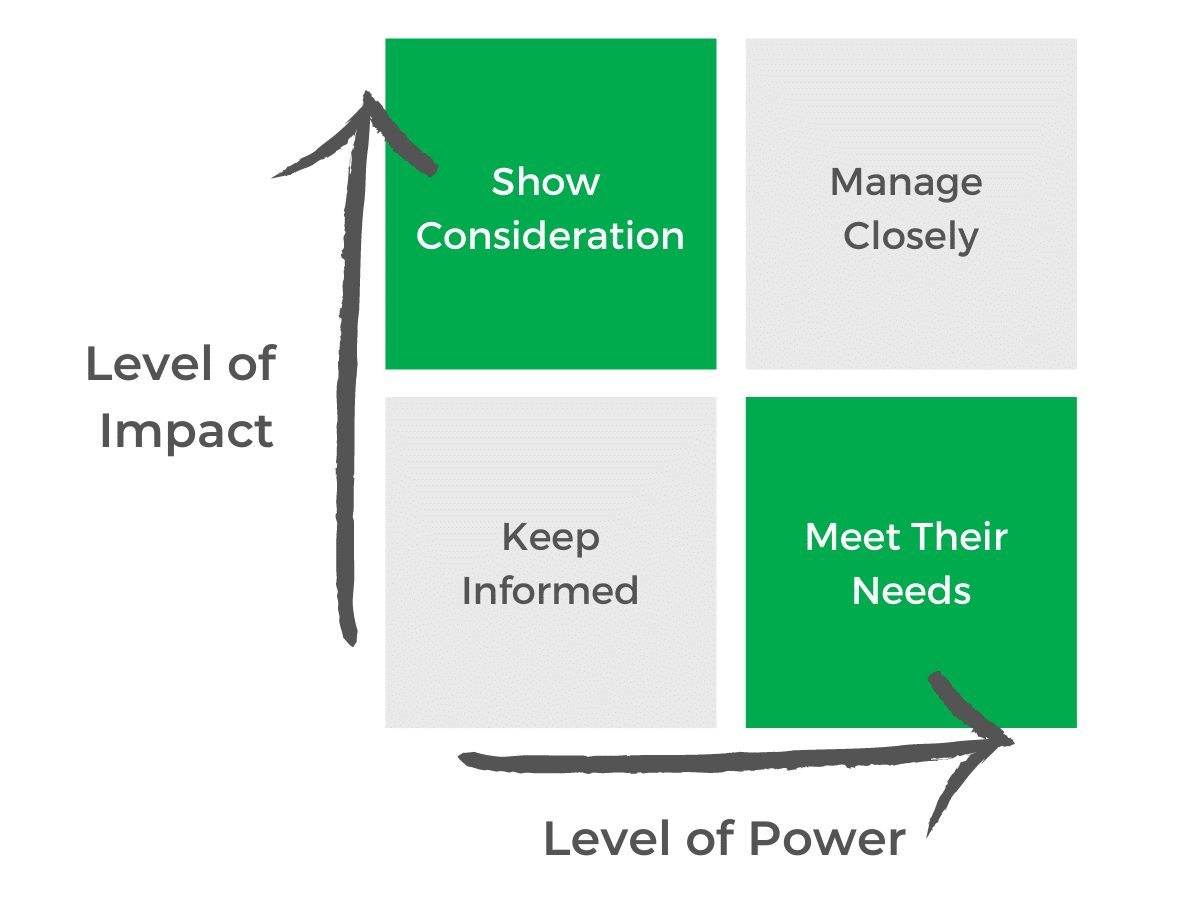You wouldn’t want to run a race or do a maze blindfolded would you? So why are you skipping internal stakeholder engagement during content projects?
At CSI, we engage our internal stakeholders regardless of the nature or scope of the project. We know internal stakeholder engagement is a big deal, and so should you. In fact, we’re so sure about it that we’ll go as far as to say that you should always engage your stakeholders.
Don’t believe us? Then keep reading. We’ll explain what stakeholder engagement is and why it’s so important. We’ll also teach you how to navigate your next engagement. That way, you can get the most out of this under-utilized stage of the content project. Download our free Stakeholder Engagement Matrix spreadsheet to get started.
What is internal stakeholder engagement?
Internal stakeholder engagement is the process of involving individuals from within your organization in a content project. Include people who may be affected by the project, or who may have significant insights into the work you’re setting out to do.
You can carry out stakeholder engagement in many ways. At CSI, we use three styles of stakeholder engagement, based on the needs of the project and the types of stakeholders involved. These are:
- Interviews and focus groups: Speaking to stakeholders to gather insights on their content experiences, attitudes, wants, and needs.
- Alignment workshops: Bringing key stakeholders together to develop a common understanding of project components. For example, to define vocabulary or roles.
- Collaborative workshops: Inviting stakeholders to use their expertise and experience to help design a solution.
We’ll dive deeper into these engagement methods in future blog posts.
Why is stakeholder engagement important?
Projects are far more likely to be successful if you’ve taken the time to engage your internal stakeholders.
An effective stakeholder engagement will result in insights you can use to design and drive your content project. It is also an opportunity to encourage individuals within the organization to learn about and understand the project. As a result, better understanding increases the likelihood that the project will be accepted and supported.
Here are some other potential benefits:
- It provides a more comprehensive solution. Stakeholder engagement considers organizational needs from multiple perspectives. Marketing teams will have different priorities than product teams, and product teams will have different priorities than sales. Taking the time to talk to all relevant stakeholders means you will create a solution that considers the needs of all parties.
- There’s more buy-in and less pushback. Stakeholder engagement gives you the opportunity to understand and resolve the issues brought up by skeptical stakeholders, and turn supportive stakeholders into champions of your project. It’s also a good time to identify potential roadblocks. These roadblocks could be people, regulatory concerns, or other factors that might affect the project’s success.
- You consolidate existing knowledge. Often, organizations have done research, had conversation, and run consultations that are relevant to the current content project. When you consult with stakeholders, you can unearth this useful information, and avoid doing the same work twice.
- You ensure a solution that meets business needs. This is worth saying over and over again – stakeholder engagement helps you create content that truly meets organizational needs. By engaging with stakeholders who might be directly or indirectly affected by the project, you can be sure you’re creating content that meets current and future business needs.
When done correctly, stakeholder engagement can create a more sustainable content project plan that meets organizational needs. Stakeholder engagement keeps everyone involved in the process, and reduces the chance of opposition or obstacles further down the road.
Who should be included in your stakeholder engagement process?
The nature and scope of your project will determine who you should talk to. The number can vary depending on how many parts of the organization your project will impact and who might have helpful insight. For example, if you’re working on a small section of your company website, there may only be one department that is impacted. In this case, you may engage only a couple of people from that department to get the insight you need.
But if you have a medium- to large-sized content project on your hands, you may need to talk to more people. The scope of the project, available time, and budget will all impact who is included in the stakeholder engagement.
In general, the following list represents an outline of who should be considered for stakeholder engagement. This is not a comprehensive list so much as a guide for your analysis. If you’re having trouble identifying relevant individuals, it can be useful to map the workflow of the content project. This step can clarify which departments and teams need to be involved.
Who to include in stakeholder engagement:
- Senior managers overseeing the project.
- Individuals who play a role in sign-off or approval (legal, subject matter experts, etc.).
- Individuals who are creating the content.
- Individuals who are implementing the project.
Once you have put together a list of the stakeholders who need to be involved in the engagement, it’s time to sort your stakeholders using a stakeholder engagement matrix.
Stakeholder Engagement Matrix
During stakeholder engagement, it’s important to differentiate the decision makers from those who are supporting the project. You can do this by mapping out your stakeholders based on their power and level of impact. Each stakeholder will require a different level of involvement and attention, based on where they sit in the matrix.
Power refers to a stakeholder’s ability to promote, change or stop the content project.
Impact refers to the extent to which a stakeholder will be affected by the changes or results of the project. For example, individuals can be impacted by changes to: how a process is completed, who is responsible for completing a process, and new budgets, among other variables.
Stakeholder groups:
- Keep informed: These stakeholders are minimally impacted by the project and have little to no power to change it. They should have general access to information about the project, but are not a priority. It is not necessary to include them in stakeholder engagement.
- Meet their needs: These stakeholders are highly impacted by the project, but have little power to make changes or affect its course. Listen carefully to this stakeholder group and regularly provide them with information concerning project decisions. Since they cannot influence the course of the project themselves, it is your job to make sure their needs are met as well as possible, while meeting other project needs.
- Show consideration: These stakeholders are not impacted by the project, but do have the power to influence it. Keep this group happy by letting them know how the project will positively affect them and their department. It is important that this group understand the content project and support it, but you need to balance their opinions with the needs of other groups.
- Manage closely: The most important stakeholder group, these individuals are heavily impacted by the project and have the power to champion the project or create obstacles. Listen and engage thoroughly with this group of stakeholders, but do not forget to consider the needs of those who are similarly impacted but without the same amount of power.
What should you be trying to learn?
Each style of engagement provides its own unique value.
One-on-one interviews and alignment workshops are ideal during the discovery phase of your project. One-on-one interviews can reveal important considerations for your project, including stakeholder expectations and potential roadblocks. Alignment workshops can be used to create a shared understanding of the project. For example, discussions during alignment workshops should include defining terms, project goals, roles and responsibilities. During the discovery phase, think about how each individual’s insights can contribute to the project and identify knowledge gaps that need to be further explored through research.
On the other hand, collaborative workshops should be implemented during the design phase of a project. This is your chance to use each stakeholder’s subject matter expertise to brainstorm ideas, make decisions, and generate potential solutions. You should begin a collaborative workshop expecting your project to change. Being adaptable is necessary if you are serious about committing to a fully inclusive, interactive and effective engagement.
Tips for running a successful engagement
- Foster an environment of collaboration, inclusion and support. You are not there to strong arm stakeholders into agreeing to a pre-determined plan. Instead, the project should be built up and molded to organizational needs, based on the feedback you get during the stakeholder engagement process.
- You are not obliged to act on every suggestion. During stakeholder engagement, there will always need to be some compromise since not every stakeholder will agree on every point. However, make sure stakeholders understand that they are being listened to, and provide feedback on why you are or are not going ahead with a certain aspect of the project.
- Before you start, take time to explain the project and the stakeholder engagement process. Provide information on who is involved, how long it will take, and what you are trying to accomplish. Giving stakeholders more context helps them feel truly involved and integrated into the process.
Remember, everyone involved in stakeholder engagement is there in the organization’s best interest. Conflicting opinions do not hurt the process – they initiate conversations that build a strong foundation for future success. So be open-minded, provide encouragement, and see where the process takes you.
Further reading
To help you get started, here are some resources to guide your next stakeholder engagement.
- Content toolkit: Content RACI templates – A RACI chart template you can use to clarify the roles and responsibilities of each person involved in a project. You can also learn how to use a RACI chart.
- How to run stakeholder interviews – Stakeholder interviews are a great way to gain insight into the expectations, opportunities, and limitations of an upcoming content project.

